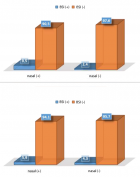Early Online (Volume - 7 | Issue - 1)
Management and Therapeutic Strategies for Spinal Muscular Atrophy
Published on: 29th March, 2024
Spinal muscular atrophy is an autosomal recessive neuromuscular disorder characterized by progressive muscle weakness and atrophy. It is one of the most common single-gene disorders with an incidence rate of approximately 1 in 10,000 live births. The clinical manifestations are progressive hypotonia and muscle weakness due to the degeneration of alpha neurons in the anterior horn cells of the spinal cord and motor nuclei in the lower brain stem. Depending on the severity of the symptoms, SMA has five subtypes. Supportive measures can be offered for respiratory, gastrointestinal, and musculoskeletal complications. Carrier testing for all couples is recommended and this can be done by Multiplex Ligation-dependent Probe Amplification (MLPA). Prenatal diagnosis can be offered to carrier couples. Therapies must be given within the newborn period for maximum benefit and before the loss of motor neurons. It is achieved by identifying the SMA babies through Newborn screening. Several new FDA-approved drugs can reduce the progression of symptoms in SMA. However, they cannot offer a definite cure. Clinical follow-up and Neurological assessment demonstrate that SMA children can attain developmental milestones after receiving treatment, which is never normally attained in untreated cases. In utero SMA treatment with Zolgensma would enhance the survival rate and favorable neurological outcomes in the future. Base editing and Gene editing with CRISPR-Cas technologies to target the mutations and restore functional and stable SMN protein levels are the future hopes for a permanent cure of SMA.
A Critical Review on Some Recent Developments in Comparison of Biological Sequences
Published on: 25th April, 2024
The present review highlights some of the very important contributions to non-alignment ways of comparing biological sequences, which may be genome sequences of nucleotides, protein sequences of amino acids, or sequences of protein secondary structures. The discussion centers around specific methods applicable to the comparison of three types of sequences. The methods of comparison of genome sequences are based on three pairs of biological groups of nucleotides; the same for protein sequences are based on either physio-chemical property values of amino acids or on classified groups of amino acids of different cardinalities obtained from the physio-chemical properties; the same for sequences of secondary structures of proteins are based on their sequential expressions of structure elements of cardinality three and four. Comparison is made in the time domain and also in the frequency domain. Different taxa of known phylogeny are considered for comparison. It tries to find out the specific method of comparison, which can show the exact phylogeny of the taxa. If a new sequence appears in the database, it becomes essential to know its phylogeny. For this purpose, a phylogenetic tree is drawn on the sequences of the known taxa together with this new sequence using the best possible method. If the species having this new sequence belongs to the old taxa, there is nothing to worry about. Otherwise, the species with the new sequence has to be studied separately. This is the general reason for the construction of a phylogenetic tree in any form of biological sequence comparison.
Germline BRCA1 Mutation inSquamous Cell Carcinoma of Oesophagus: Driver versus Passenger Mutation
Published on: 2nd July, 2024
We report a rare case of 62-year-old South Asian women who visited the Molecular Pathology and Genomics Department for hereditary germline cancer genetic testing after being diagnosed with oesophageal cancer, reported as invasive keratinizing squamous cell carcinoma metastasized to the lymph nodes. Her personal history revealed that she was diagnosed with triple-negative breast cancer five years before oesophageal cancer. Germline cancer testing showed pathogenic variants in BRCA1 gene c.68_69delAG, which proved it a hereditary breast and ovarian cancer syndrome. She was started on PARP inhibitors but developed some secondary respiratory failure and succumbed to death. Less than 10 cases have been reported in the literature of the association of germline BRCA1 and Squamous cell Carcinoma – the esophagus. The article focuses on the probable pathogenesis of BRCA1 mutation with non-classic malignancies and the response of Poly adenosine diphosphate ribose polymerase inhibitors (PARP) inhibitors in such a scenario. We report an unusual manifestation of the BRCA1 gene with second primary oesophageal squamous cell cancer occurring five years later to triple-negative breast cancer.
A Review on Heavy Metals in Ecosystems, Their Sources, Roles, and Impact on Plant Life
Published on: 21st August, 2024
The presence of heavy metals (HMs) on Earth is essential to all forms of life. These metals are essential for plant and animal development but can have numerous negative effects on the living environment. In this review, we looked at where HMs come from, why they are harmful, and how they affect plants. Articles indexed in Google Scholar, PubMed, Research Gate, Science Direct, and a few books on heavy metals were consulted for this study. Heavy metals are essential for plant development and growth. According to this analysis, the hazardous effects of HMs are on the rise all throughout the globe, and this trend may be attributed mostly to human activity. Because of its impact on agricultural productivity and environmental changes, soil pollution caused by HMs is among the most crucial elements. Plants have evolved very sophisticated defense systems to deal with these environmental challenges. The threat that HM stress poses to plants has attracted a lot of attention worldwide because it could stunt agriculture’s long-term expansion. In spite of their importance for plants, this study found that HMs pose a significant threat to plant life. The novelty of this review lies in its detailed examination of both the beneficial and detrimental roles of HMs, providing a balanced perspective often overlooked in current literature. The significance of this work is underscored by its potential to inform sustainable agricultural practices and environmental management strategies, as it highlights the delicate balance required to harness the benefits of HMs while mitigating their risks. Despite their necessity for plant development, this review underscores the significant risks HMs pose to plant health and ecosystems.Less than 10 cases have been reported in the literature of the association of germline BRCA1 and Squamous cell Carcinoma – the esophagus. The article focuses on the probable pathogenesis of BRCA1 mutation with non-classic malignancies and the response of Poly adenosine diphosphate ribose polymerase inhibitors (PARP) inhibitors in such a scenario. We report an unusual manifestation of the BRCA1 gene with second primary oesophageal squamous cell cancer occurring five years later to triple-negative breast cancer.

HSPI: We're glad you're here. Please click "create a new Query" if you are a new visitor to our website and need further information from us.
If you are already a member of our network and need to keep track of any developments regarding a question you have already submitted, click "take me to my Query."

















































































































































